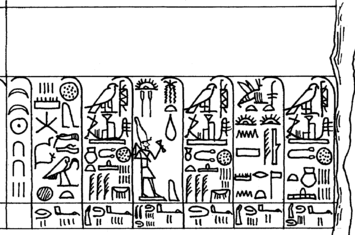10 (hieroglyph)
| ||
| " 10 " (numeral) mt in hieroglyphs |
|---|
Kom Ombo Temple Calendar relief.
(Row 1: 10 + 10)
(Row 1: 10 + 10)
The numeral 10 (hieroglyph) is Gardiner sign listed No. V20, in the category of rope, fiber, baskets, bags, etc. It is found in hieroglyphs, often in association with counting, or accounting (months, days, or seasons, for example), and has an Egyptian language phonetic value of mt.[1] It is similar to a fetter-shaped object(?), described by Budge, 1920, (1978), as "objects of wood or wickerwork; terrify, terrible,"[2] (now in Gardiner's list as V19 and Aa19
). (Budge also shows a 3rd variety.)
|
Palermo Stone usage, 2390 BC

Graphic showing "year-date"-
(left column, "Month-
2, Day-
23-(10 + 10 + 3)"), Row V (Palermo Piece)
|
|
|
|
|
|
(7 "year-dates" are represented in the graphic)
_1.jpg)
The Palermo Piece (at Palermo Museum) of the 7—piece Palermo Stone.
The numeral 10 hieroglyph is used extensively in the 24th century BC Palermo Stone, as the record of Nile River Flood levels of some King-Year records – use the numeral "10". It is also in a few of the King Year-Registers that record: "year-date"-
(month & days), or especially Row VI (of the VI rows on the Palermo Piece (of the 7—piece stone)), where accounting of fowl, and cattle is recorded, using numeral 10.
|
|
Preceded by
" Behold! " mk (mek) |
" 10 " (numeral) mt |
Succeeded by
1/10th mt-nu |
See also
| Wikimedia Commons has media related to 10 (hieroglyph). |
References
- Budge. An Egyptian Hieroglyphic Dictionary, E.A.Wallace Budge, (Dover Publications), c 1978, (c 1920), Dover edition, 1978. (In two volumes, 1314 pp. and cliv-(154) pp.) (softcover, ISBN 0-486-23615-3)
This article is issued from Wikipedia - version of the 11/21/2016. The text is available under the Creative Commons Attribution/Share Alike but additional terms may apply for the media files.